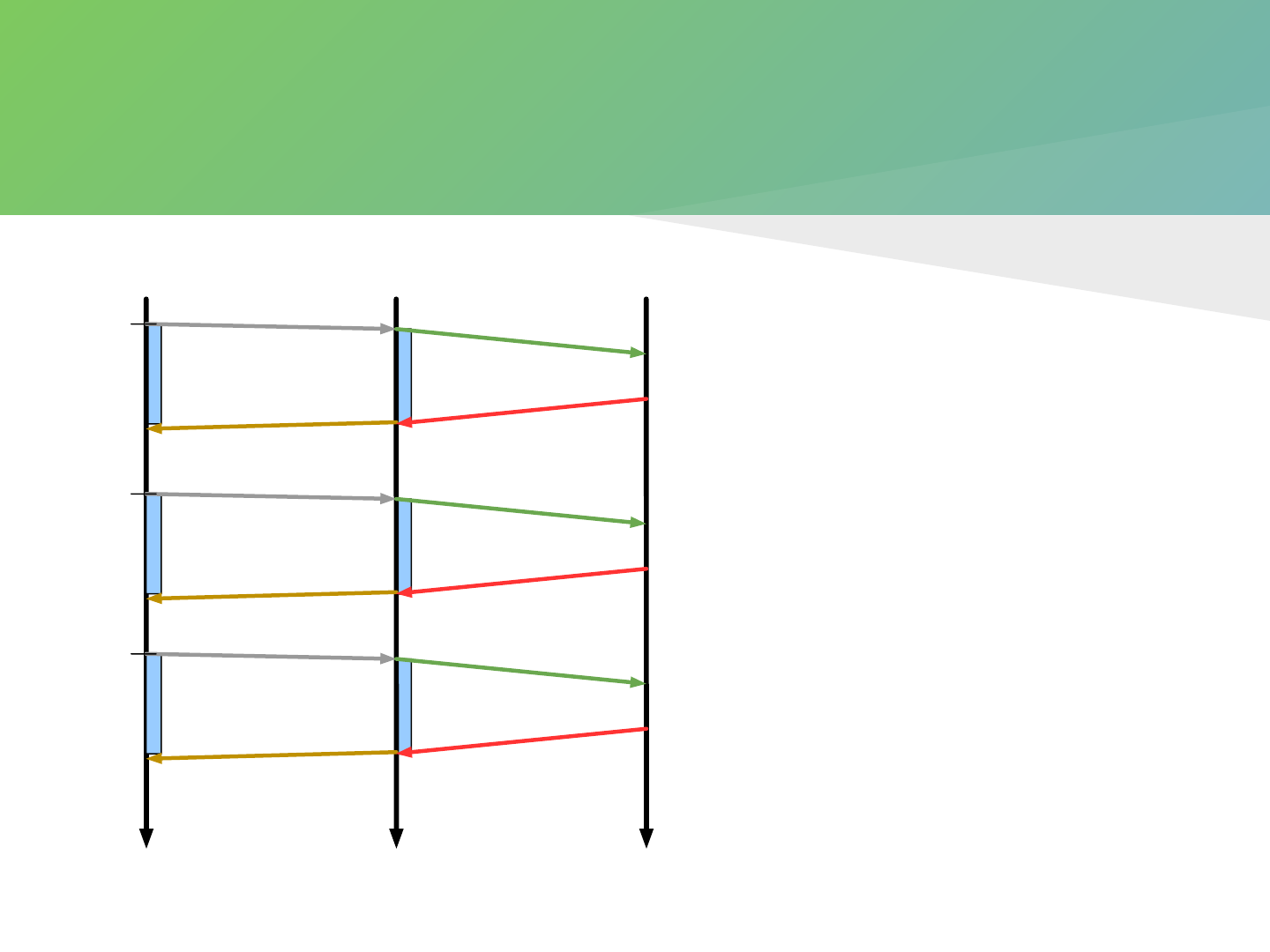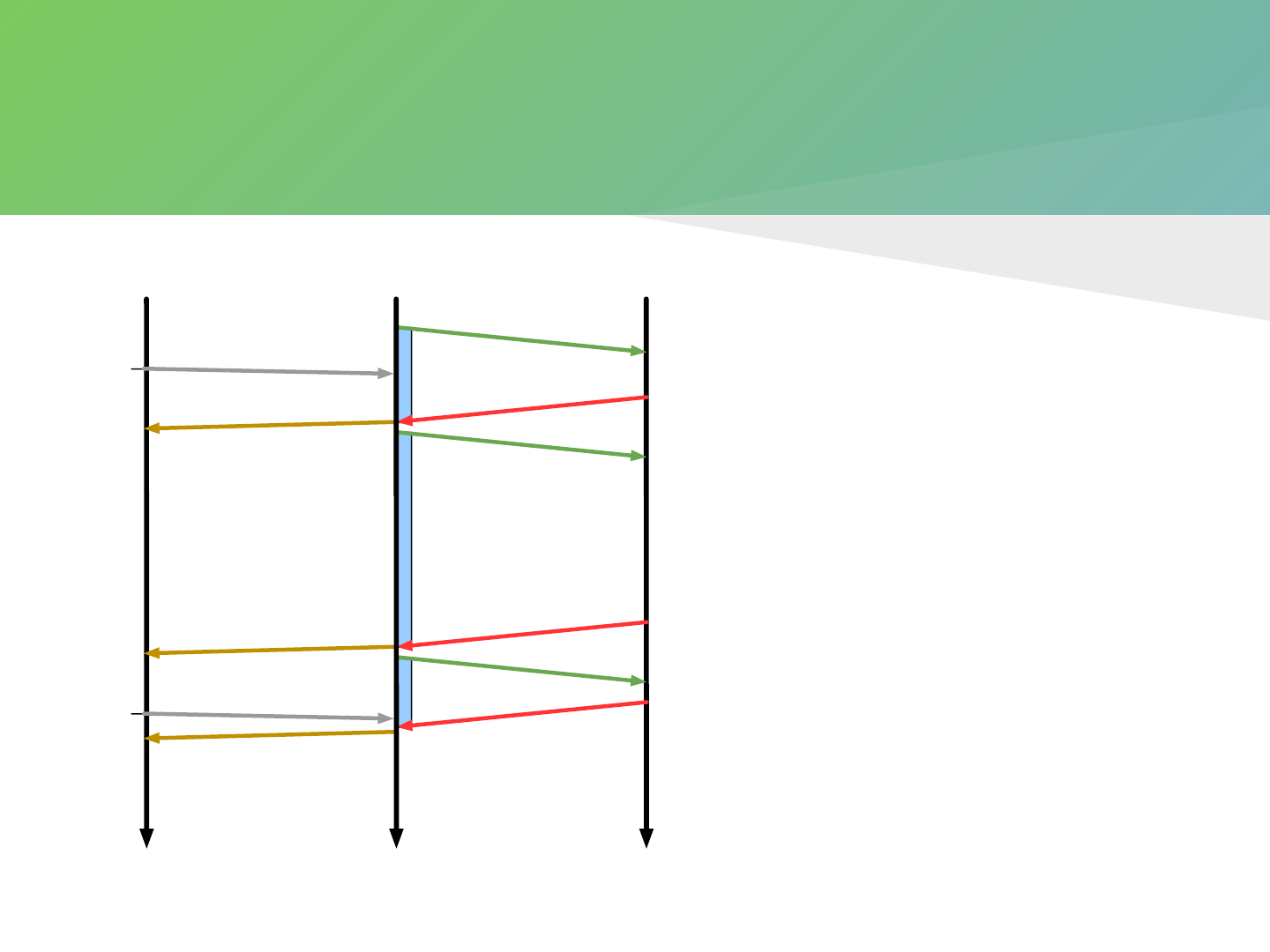
From Data Push to
WebSockets
The History of Data Push and the
Lightstreamer Technology
Last updated: 17 Oct 2018
Alessandro Alinone

Agenda
● History of Data Push
● Lightstreamer Technology
● Lightstreamer Success Stories
● MQTT.Cool and JMS Extender

What Is Data Push?
Information is delivered on the fly as soon as it
is generated. Web pages and mobile apps are
updated in real time.
Many application domains are taking benefit from push technology:
● Financial Services: Online trading platforms for capital markets, live price
dissemination, order submission, spread betting
● Gaming: Sports betting, online casinos, online multiplayer video games
● Aerospace and Defense: Web telemetry of space vehicles, satellites, and
aircrafts, web-based management of airport operations
● Media: social TV, second screen, sports event live data
● Transportation and Logistics: live tracking, supply chain monitoring
● Alerting: Emergency mass notification systems
● And many others: Social networks, in-app notifications, online
collaboration tools, online auctions, systems monitoring, e-learning, etc.

Many Terms Used
to Refer to Data Push
Real-Time Messaging
Push Technology
Web Streaming
WebSockets
Comet
Long Polling
Real-Time Web
Web Push
Real-Time Notifications
Internet Messaging
Data Streaming
Data Push
Last Mile Messaging
Reverse Ajax
Ajax Push
and others...
In-App Messaging
In-App Notifications
Push Notifications

The Four Waves
of Data Push
● 1996-2000: Webcasting
Coarse-grained daily updates
● 2000-2012: Comet
(the term "Comet" was coined by Alex Russell in 2006, but Comet technologies existed since 2000)
Polling, long polling, streaming
● 2009 onwards: Push Notifications
Apple APNs, Google FCM (previously C2DM and GCM), Web
Push protocol
● 2012 onwards: WebSockets
Full-duplex bidirectional streaming

Second Wave:
the Raise of Data Push
● 2000: Online financial trading systems required
data push for real-time stock price delivery
● Requirements:
○ Fine-grained updates
○ Real-time updates (low latency)
● Very first players: Lightstreamer, Caplin,
Pushlets, KnowNow
● Technology:
○ Front-end: HTML and/or Java applets
○ Transport techniques: Ajax polling, Comet long
polling, and Comet streaming

An Example to Help Illustrate
A temperature and
humidity sensor must send
data to a Web browser
(
sensor example
).
Let's see how this might
have been done in the
history of push technology.
Web

HTTP/1.1
Request
GET / HTTP/1.1
Host: www.facebook.com
User-Agent: Mozilla/5.0 (Windows NT 6.1; WOW64; rv:16.0)
Gecko/20100101 Firefox/16.0
Accept:
text/html,application/xhtml+xml,application/xml;q=0.9,*/*;q=0.8
Accept-Language: en-US,en;q=0.5
Accept-Encoding: gzip, deflate
Connection: keep-alive
Cookie: datr=IeCPUJWOBWaU0LrmpOTOC-YX;
reg_fb_gate=http%3A%2F%2Fwww.facebook.com%2F;
reg_fb_ref=http%3A%2F%2Fwww.facebook.com%2F;
wd=1080x1281
Cache-Control: max-age=0
Response
HTTP/1.1 200 OK
Cache-Control: private, no-cache, no-store, must-revalidate
Expires: Sat, 01 Jan 2000 00:00:00 GMT
P3P: CP="Facebook does not have a P3P policy. Learn why here:
http://fb.me/p3p"
Pragma: no-cache
X-Content-Type-Options: nosniff
X-Frame-Options: DENY
X-XSS-Protection: 1; mode=block
Set-Cookie: reg_ext_ref=deleted; expires=Thu, 01-Jan-1970 00:00:01
GMT; path=/; domain=.facebook.com
Set-Cookie: wd=deleted; expires=Thu, 01-Jan-1970 00:00:01 GMT;
path=/; domain=.facebook.com; httponly
Content-Encoding: gzip
Content-Type: text/html; charset=utf-8
X-FB-Debug:
4wzuaiMEh5R1tzwT7CBNVncjMl1zLu3fmz4CvMLu+UQ=
Date: Tue, 30 Oct 2012 14:16:12 GMT
Transfer-Encoding: chunked
Connection: keep-alive
2d2e
...........}[o#Y..{..lNO..-..[...u.J...R.&.L&........j....0.'...a.afoX.^`.{...3.`.
{.....?._..L&/.....w.]...d.s.....'"...7.6N..[R...k_..?..
COMPRESSED CONTENT..........................................
Request
Response

Full Page Refresh
Typical issues:
● Low update frequency; no
real time
● High bandwidth usage
● High load on Web server
Sensor example: for each
refresh, the full HTML page
with the current values is
retrieved
wait...
wait...
wait...
Refresh 1
Browser Server
wait...
Refresh 2
User
wait...
Refresh 3
wait...

Ajax Polling
Typical issues:
● Low update frequency; no
real time
● High bandwidth usage (but
lower than page refresh)
● High load on Web server
Advantages:
● User interface is never
blocked
Sensor example: for each
poll, the current values are
retrieved
wait...
wait...
Action 1
Browser Server
Action 2
User
wait...

Comet Long Polling
(or HTTP Long Polling)
Typical issues:
● Medium update frequency;
near real time
● Medium bandwidth usage
(HTTP headers still present
in each round-trip cycle)
● High load on Web server
Advantages:
● User interface is never
blocked
● Low latency on
low-frequency events
Action 1
Server
Action 2
User
wait...
wait...
wait...
Browser

Sensor example: for each
poll, the new values are
retrieved only when they
become available. Otherwise,
the request is kept pending
(long poll)
Action 1
Server
Action 2
User
wait...
wait...
wait...
Browser
Comet Long Polling
(or HTTP Long Polling)

Comet Streaming
(or HTTP Streaming)
Typical issues:
● May be blocked by some
anti-virus software
mounted on proxy servers
Advantages:
● High update frequency;
low latency; true real time
● Low bandwidth usage
(very little overhead)
● Low load on the network
infrastructure
Action 1
Server
Action 2
User Browser

Action 1
Server
Action 2
User Browser
Possible techniques:
● Iframe streaming
● XHR streaming
● Flash streaming
● Server-Sent Events (SSE)
Sensor example: the server
keeps pushing real-time
updates as they become
available, whatever is the
frequency, without
request/response round trips
from the client
Comet Streaming
(or HTTP Streaming)

Third Wave:
WebSockets
● Goal:
○ Full-duplex asynchronous communication between a
web client and a web server
● Why not just plain TCP?
○ Client runs untrusted code: origin-based security
model; ports 80/443
○ WebSockets are message oriented (
onmessage
,
send
),
TCP is stream oriented
○ WS split messages into frames, to allow:
■ Sending messages of unknown size without buffering
■ Multiplexing more logical channels on the same connection
■ Masking (XOR with random key) frames sent from the client to
prevent cache poisoning on flawed proxy servers

WebSockets
Typical issues:
● There might be some
firewall or proxy still
blocking WebSockets
Advantages:
● Same as HTTP Streaming
Action 1
Server
Action 2
User Browser
Sensor example: it's a
unidirectional scenario (from
server to client), so with
WebSockets the behavior is the
same as with HTTP Streaming.

WebSockets vs. HTTP/1.1
Myth:
WebSockets are better than HTTP for sending data from the server to
the client (use less bandwidth, have lower latency, etc.)
Myth debunked:
When sending data from the server to the client, WebSockets and
HTTP Streaming behave exactly the same way.
After handshake, pure payload over TCP is streamed in both cases
(WebSocket framing and HTTP chunking have a negligible difference)

ServerBrowser
The real difference is for bidirectional scenarios:
ServerBrowser ServerBrowser
TCP connection 1 TCP connection 1 TCP connection 2
WebSocket
HTTP
1. HTTP requires at least 2 sockets
2. HTTP requires full round trip for each request
(by default there is no pipelining)
3. HTTP gives no control over connection reuse
(risk of a full SSL handshake for each request)
4. HTTP gives no control over message ordering
WebSockets vs. HTTP/1.1

What About HTTP/2 ?
HTTP/2 improves performance over HTTP/1.1:
● Pipelining of requests
● Multiplexing of requests
● Compression of headers
● HTTP/2 server push
What is HTTP/2 server push?
● It is not a notification mechanism
● It can send page resources without waiting for requests
● It does not replace WebSockets
● It is possible to combine Server-Sent Events (SSE) and
Multiplexing to "emulate" WebSockets (with no
particular benefits)

In-app Notifications vs.
Push Notifications
In-app Notifications (Data Streaming):
● Server sends real-time data directly to the app
● The app needs to be running to receive the data
● High throughput
● Low latency
● Guaranteed delivery
Push Notifications:
● Server sends notifications to Google/Apple servers
● Google/Apple servers send notifications to the device
● The app does not need to be running to get the data
● Low throughput
● No control over latency and actual delivery

Lightstreamer Technology

What Is Lightstreamer?
Lightstreamer is a real-time message broker
optimized for the Internet
● Implements WebSockets and HTTP Streaming/Polling
● Implements native push notifications
● Massively scalable
● Passes through any kind of network intermediary
(firewalls, proxies, etc.)
● Supports any client-side platform
● Integrates with any back-end infrastructure
● Automatically throttles bandwidth
● Supports custom authentication and authorization
● World class track record

Lightstreamer Architecture
Server
Data Adapter
Metadata Adapter
Web Server
Back-end
Systems
Internet
Clients
(Browsers,
Mobile Apps,
IoT Devices,
etc.)
Lightstreamer Server: stand-alone process that runs in a Java virtual machine
Lightstreamer Data Adapter: custom component based on the provided API
(Java, .NET, Node.js, Python, and TCP sockets) that attaches to the data feed
and injects the real-time data flow into the Server
Lightstreamer Metadata Adapter: custom component based on the provided
API (as above) that manages authentication and authorization

Rich Set of Lightstreamer
Client APIs
● Web (compatible with any browser, including older browsers and
mobile browsers; supports frameworks like Angular, React, Vue,
as well as hybrid frameworks, such as PhoneGap and Electron)
● Android
● Apple (iOS, macOS, tvOS, and watchOS)
● Microsoft (.NET and Excel)
● Java SE
● Node.js (for both server-side code and React Native apps)
● Python
● Unity
● Legacy (Adobe Flash, Flex, AIR; Silverlight; Java ME;
BlackBerry; Windows Phone)
● Generic clients based on the TLCP open protocol
(see https://lightstreamer.com/docs/client_TLCP_base/TLCP%20Specifications.pdf)

Logical Layers of
Lightstreamer Server
Security
SecurityMonitoring
Optimized Delivery
Bandwidth and frequency control; smart throttling;
conflation; resampling; delta delivery; batching
Multichannel Transport
Bidirectional transport layer with firewall and proxy
traversal; StreamSense; native push notifications
Message Routing
Publish-subscribe; multiplexing; fan-out
SecurityScalability

Logical Layers of
Lightstreamer Server
Security
SecurityMonitoring
Optimized Delivery
Bandwidth and frequency control; smart throttling;
conflation; resampling; delta delivery; batching
Multichannel Transport
Bidirectional transport layer with firewall and proxy
traversal; StreamSense; mobile push notifications
Message Routing
Publish-subscribe; multiplexing; fan-out
SecurityScalability

● Automatic and fast detection of the best transport on a
per-client basis
● Upper layers are fully abstracted from the actual
transport
Multichannel Transport:
StreamSense
WebSockets
HTTP Streaming
HTTP Smart Polling

● Efficient and reliable bidirectional channel provided in
all the cases (whatever is the underlying transport)
● Messages sent from the client to the server have
in-order guaranteed delivery with automatic batching
● Lightstreamer enriches HTTP:
○ Messages are acknowledged explicitly
○ Lost messages are retransmitted automatically
○ Out-of-order messages are reordered automatically
○ Underlying socket is kept open for reuse via reverse heartbeats
○ Multiple requests are automatically batched, to highly reduce the
number of HTTP round trips
Multichannel Transport:
Bidirectional Channel
See live Round-Trip Demo:
https://demos.lightstreamer.com/RoundTripDemo/

● Data can be delivered to mobile clients using native
push notifications too
● Apple APNs and Google FCM are supported
● If an app is not active, the device will receive live
updates in any case
● No extra development on the server side: messages
originated from the Data Adapter can use both the
streaming channel and the push notification channel
● Trigger support: determine what messages should
result in a push notification
Multichannel Transport:
Push Notifications

Logical Layers of
Lightstreamer Server
Security
SecurityMonitoring
Optimized Delivery
Bandwidth and frequency control; smart throttling;
conflation; resampling; delta delivery; batching
Multichannel Transport
Bidirectional transport layer with firewall and proxy
traversal; StreamSense; mobile push notifications
Message Routing
Publish-subscribe; multiplexing; fan-out
SecurityScalability

publishes
● Client subscribes to items with schemas (sets of
fields):
● Data Adapter publishes on demand:
Message Routing:
Publish-Subscribe
Client
subscribes
Field "A"
Item 1
Field "B"
Field "C"
Field "X"
Item 2
Field "Y"
Field "A"
Item 3
Field "X"
Field "C"
Field "Y"
Data Adapter
start publish
Item 1
Item 1
snapshot
Item 1
update 1
Item 1
update 2
publishes
Data Adapter
start publish
Item 2
Item 2
snapshot
Item 2
update 1
Item 2
update 2

Message Routing:
Publish-Subscribe
Client
delivers
Item 1
snapshot
Item 1
update 1
Item 2
snapshot
Item 1
update 2
Item 2
update 1
● Server sends multiplexed data to Client:
● Any routing scenario is supported (broadcast,
multicast, unicast):
publishes
Item 1
publishes
Item 1
(once)
Data Adapter
Client 1,000,000
Client 1
...
Massive fan-out,
broadcast
Data Adapter
Client 2
Client 1
publishes
Item 2
item 1
item 1
item 1
item 2
Personal messages,
unicast

Message Routing:
Publish-Subscribe
Data Adapter
Client
Publisher Subscriber
● Asymmetric pub-sub:
○ In many scenarios the "data feed" is completely different from the
data consumer (topology, protocol, business model)
○ Optimization for massive publishing from server-side data feeds
● Clients can still publish:
○ The Client (Subscriber API) can send messages to the Adapter to be
processed and possibly incorporated into the data stream
Data Adapter
Client
Publisher Subscriber
sendMessage

Logical Layers of
Lightstreamer Server
Security
SecurityMonitoring
Optimized Delivery
Bandwidth and frequency control; smart throttling;
conflation; resampling; delta delivery; batching
Multichannel Transport
Bidirectional transport layer with firewall and proxy
traversal; StreamSense; mobile push notifications
Message Routing
Publish-subscribe; multiplexing; fan-out
SecurityScalability

Optimized Delivery:
Filterability
● Data filterability
○ Based on the nature of the data, series of updates
to an item can be filtered, to reduce frequency, via:
■ Queueing
■ Resampling
■ Conflation
● Lightstreamer's filtering
○ For each subscription of each client, Lightstreamer
allows to define how data can be filtered, with
several parameters
○ Filtering is then applied on the fly to the data
stream based on a number of static and dynamic
conditions

Optimized Delivery:
Throttling
● Bandwidth Control
○ For each client, a maximum bandwidth can be
allocated to the multiplexed stream connection
● Frequency Control
○ For each subscription of each client, a maximum
update frequency can be allocated
● Smart Throttling
○ Internet congestion is detected
Lightstreamer heuristically combines these
three variables to dynamically throttle the data
flow with filtering
See live Bandwidth and Frequency Demo:
https://demos.lightstreamer.com/BandwidthDemo/

Optimized Delivery:
Other Mechanisms
● Batching and TCP packet optimization:
○ Data is aggregated efficiently within TCP packets
○ Configurable trade-off between latency and overhead
reduction, overriding Nagle's algorithm
● Lightweight protocol:
○ Position-based protocol with negligible overhead (no JSON, no
XML, no metadata redundancy)
● Delta delivery:
○ For subsequent updates to an item, only the actually changed
fields (delta) are sent; custom selectors available
● Multiple subscription modes:
○ MERGE, COMMAND, DISTINCT, RAW
See live Market Depth Demo:
https://demos.lightstreamer.com/MarketDepthDemo/

Logical Layers of
Lightstreamer Server
Optimized Delivery
Bandwidth and frequency control; smart throttling;
conflation; resampling; delta delivery; batching
Multichannel Transport
Bidirectional transport layer with firewall and proxy
traversal; StreamSense; mobile push notifications
Message Routing
Publish-subscribe; multiplexing; fan-out
Security
SecurityMonitoring
SecurityScalability

Scalability
● Concurrent staged event-driven architecture
○ Non-blocking I/O used for all types of connections
○ Graceful degradation of the quality of service
○ Tested on a single box with:
■ One million connections with low frequency traffic
■ Tens of thousands of connections with very high
frequency traffic
● Vertical scalability
○ An instance of Lightstreamer Server can fully
leverage multiple CPUs and cores available in a box
● Horizontal scalability
○ Clustering via any standard Web Load Balancer

Security
● Secure connections
○ WSS and HTTPS support based on SSL/TLS strong
encryption and configurable cipher suites
○ Server-side and client-side certificate support
● Authentication
○ Credentials are received from the client, together
with HTTP headers and connection properties
○ Custom Metadata Adapter validates them
● Fine-grained authorization
○ Every subscription and QoS request done by the
clients is authorized through the Metadata Adapter

● Monitoring Dashboard
● Logging
○ Fine-grained configurable logging, with several
categories, levels, and appenders
● JMX
○ Extensive metrics exposed via a JMX interface, to
hook into application management facilities
Monitoring

Metadata Adapter Model:
Authentication

Data Adapter Model:
Data Push

Lightstreamer Success
Stories

Some Lightstreamer Customers

Way More Customers...
300+ companies using Lightstreamer
from 6 continents.
Thousands of servers installed.
Millions of end users served.

Lightstreamer Named a
"Cool Vendor" by Gartner
Gartner, "Cool Vendors in Application
and Integration Platforms, 2012", by
Massimo Pezzini and Jess Thompson,
11 April 2012.
Cool Vendor Report 2012 cites Weswit (former name of Lightstreamer
company), with its Lightstreamer product, as innovative, impactful and
intriguing in the area of Application and Integration Platforms.
"Web streaming is an emerging form of MOM aimed at enabling back-end applications to send real-time
messages over the public Internet, typically to large numbers (up to millions) of mobile or stationary
endpoints, according to a publish-and-subscribe model". When analyzing 'Who should care' the report goes
on to explain: "ISVs, SIs and cloud service providers that require efficient, low-latency and scalable
publish-and-subscribe data distribution to mobile and Web-based endpoints should look at Web-streaming
technologies as a way to add value to their offerings by enabling reliable and relatively easy-to implement
connectivity."
Disclaimer: Gartner does not endorse any vendor, product or service depicted in its research publications, and does not advise technology users to select only those vendors with
the highest ratings. Gartner research publications consist of the opinions of Gartner's research organization and should not be construed as statements of fact. Gartner disclaims
all warranties, expressed or implied, with respect to this research, including any warranties of merchantability or fitness for a particular purpose.

Outstanding Customer Satisfaction
As Lightstreamer is pivotal in our overall offering, the Lightstreamer support team
was a key factor in our success. For its reputation in the financial industry,
choosing Lightstreamer was a no-brainer for us.
Israel Kalush, VP Engineering, eToro
Lightstreamer has been a very stable and hassle-free piece of infrastructure that
also has made our client programming life easier. We have operated a mission
critical streaming system for nearly 3 years with a minimum of operational
trouble.
Oddmar Sandvik, DNB
Our experience of Lightstreamer support has been very positive, they have set a
high bar for other vendors to strive to achieve. They are very proactive in helping
to resolve issues.
Ivan Gowan, Head of IT Development, IG

MQTT.Cool and
JMS Extender

Other Products Based on the
Lightstreamer Engine
Lightstreamer is used as the core for two specialized
products:
● MQTT.Cool
● JMS Extender
These are gateways that extend two messaging protocols
(MQTT and JMS) over the web
Any legacy JMS solution or any new IoT/MQTT platform
can easily get browser-based clients

MQTT.Cool
Native
MQTT
Clients
MQTT
Broker
Internet
Clients
(Browsers,
Hybrid Apps,
Node.js Apps)
MQTT.Cool extends any third-party MQTT broker with new out-of-the-box
features. Any web page running inside a web browser will instantly become an
MQTT client, ready to send and receive real-time MQTT messages through
firewalls and proxies.
● On the client side, a Paho-like API is provided as part of the JavaScript
client library
● On the server side, a Java hook API is provided to implement custom
authentication and authorization

MQTT.Cool Improves
Any MQTT Broker
Security
● Authenticate users with total flexibility
● Add fine-grained authorization
● Offload TLS/SSL encryption
● Increase security by avoiding direct access to the broker
Architecture
● Connect to any MQTT broker from anywhere on the Internet
● Develop web clients with friendly Eclipse Paho-like API
● Access multiple MQTT brokers with a single connection
Performance
● Scale up any MQTT broker with massive fan-out
● Always receive fresh data with adaptive throttling and conflation
● Get full control over bandwidth and event frequency

JMS Extender
JMS
Producers
and
Consumers
Third-party
JMS Server
Clients
(Browsers,
Hybrid Apps,
Node.js Apps)
Lightstreamer JMS Extender leverages the Lightstreamer technology to
extend
any third-party JMS server by:
● Extending the JMS connections from the LAN into the web
● Extending the JMS API from Java to JavaScript
● Extending the JMS server scalability
● Extending the JMS security model
Web pages can exchange messages with legacy JMS applications through the
Internet with no security issues
JMS Extender
Internet

Benefits of JMS Extender
● Connect to any JMS server from the Internet
Even from behind the strictest corporate firewalls
● Use the JMS API in your JavaScript code
Full JMS API in any web browser, as well as any Node.js application
● Massively scale out your existing JMS Server
Offload connection fan-out to the JMS Extender
● Add fine-grained authentication and authorization
The Hook API enables to implement custom security rules
● Connect to multiple JMS servers
A single JMS Extender can connect to different JMS servers
● Support for advanced JMS features
Multiple acknowledge modes, once-and-only-once message delivery, etc.






